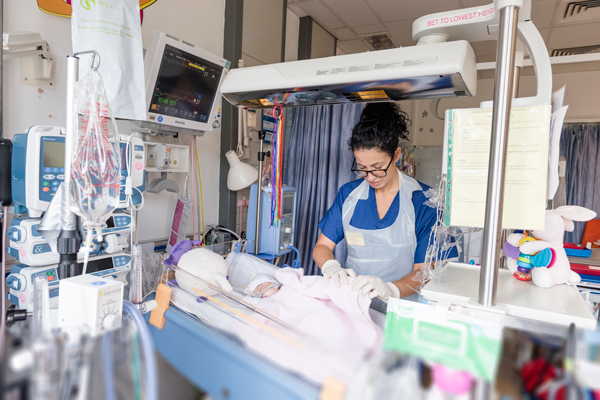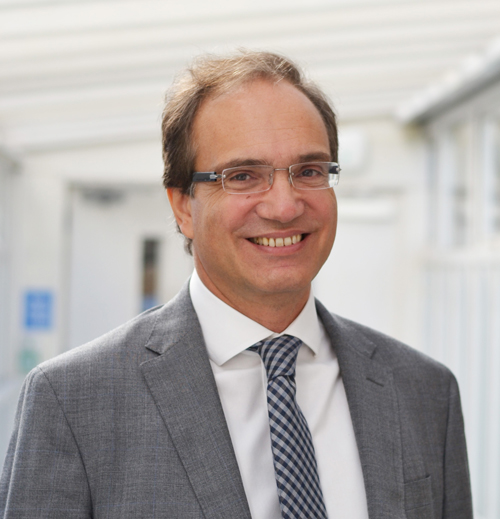 A major transformation in how we treat babies with a serious congenital heart condition has raised the survival rate to 100 per cent during a challenging period in their care.
A major transformation in how we treat babies with a serious congenital heart condition has raised the survival rate to 100 per cent during a challenging period in their care.
Hypoplastic left heart syndrome (HLS) is a defect in which the left ventricle (lower pumping chamber of the heart) is underdeveloped and much smaller than it should be, while the aorta (the main blood vessel that carries blood from the heart to the rest of the body) is usually very narrow too.
Even with medication, life expectancy is no more than four weeks. The most widely-used and successful treatment is a three-stage operation called the Norwood procedure, with one operation soon after birth, a second a few months later, and a final one at roughly four years of age depending on the child.
Data from all centres that perform the Norwood procedure shows that 20 per cent of patients do not survive between the first and second operations, the so-called 'interstage' period.
 The Trust's hypoplast programme was relaunched in 2015 by consultant paediatric heart surgeon Mr Guido Michielon, who introduced a new approach of keeping children in hospital until after they have recovered from their second operation.
The Trust's hypoplast programme was relaunched in 2015 by consultant paediatric heart surgeon Mr Guido Michielon, who introduced a new approach of keeping children in hospital until after they have recovered from their second operation.
He explains: "It is normal once a child is stable for them to be discharged until the second procedure, and for 80 per cent of them this is fine, but the complications that occur in 20 per cent of cases are invariably fatal, because these are sudden events such as arrhythmia or aspiration pneumonia that require quick intervention.
"We had the idea that being in hospital during this time would facilitate escalation of care - if the child had any complications, they are in exactly the right place."
In reality, this means babies needing to stay in hospital for many months, which is difficult for parents and resource-intensive for the Trust, so Mr Michielon launched a study to examine whether this new approach is worthwhile - and the evidence gathered is overwhelming.
He said: "Since May 2015 we have offered to keep all interstage children with HLS and its variants in hospital, with daily and weekly investigations, so we could track survival across every stage.
"Up to May 2018, we have had a total of 28 patients, of whom 26 survived the first operation. Of those, 24 parents took up the offer to remain in hospital, and we have had no mortality during the interstage period.
"What is very interesting is the 20 per cent of children did need escalation of care, in line with what we would expect, but they were taken back to theatre or moved to intensive care and all survived. Had those events happened outside hospital, they would have invariably been fatal."
Each operation in the process is major open-heart surgery and carries a degree of risk, and two patients in the study did not survive the second operation. However, 24 patients out of 28 represent a survival rate of 90 per cent, which Mr Michielon says compares "very favourably" with other centres.
The children from the study are growing up fast, and he expects to perform the first stage three operation in the Trust's new programme within the next few months.
Mr Michielon continues: "Yes this is a use of resources beyond what could be considered a normal level, but by doing this we are achieving a good quality of life for children with a condition that is fatal - and that cannot be measured. What price can you put on a child's life?"
"What is very intersting is that 20 per cent of children did need escalation of care, in line with what we would expect, but they were taken back to theatre or moved to intensive care and all survived."
Mr Guido Michielon
 The three stages of the Norwood procedure
The three stages of the Norwood procedure
Stage one
- Stabilises the child and happens soon after birth
- The surgeon enlargens the tiny aorta, inserts a shunt to improve blood flow, and reconfigures the inside of the heart so that a mix of oxygenated and non-oxygenated blood is now flowing around the body.
Stage two
- Takes place around six months of age
- The shunt (which is made of artificial material) is removed and a vein is used to create a more permanent blood flow to the lungs
Stage three
- This is called the Fontan procedure and happens at a later stage, usually around the time the child starts school.
- The procedure further reconfigures the heart to create a more 'normal' circulatory system - with oxygenated blood flowing to the body, and non-oxygenated blood going to the lungs.
< A dedicated service for children and young people
'Social Club' makes times in hospital easier for babies and parents >
